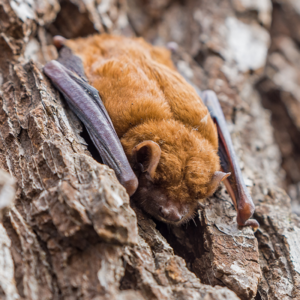Big Brown Bats in Suffolk County & Nassau County
The big brown bat is one of the bigger bat species and also likely the most widely dispersed throughout Suffolk County & Nassau County They are known to withstand conditions that other types of bats cannot, which is why they’re commonly found in cities and suburban environments alongside wooded areas. They prefer eating beetles over other insects, using their powerful jaws to chew through the beetles’ hard exoskeleton, however, they also eat moths, flies, wasps, and flying ants. Colonies range from 20 to 300 individuals and big brown bats can live a long time in the wild. That said, most die off during their first winter due to malnutrition throughout hibernation.
Big Brown Bat Habitat
Big brown bats have been found in a variety of habits including meadows, deserts, mountains, forests, suburban areas, and cities. They will hibernate in caves, mines, walls, attics, or other buildings. They enter into hibernation in November, often less than 50 miles away from their summer roosts. They hibernate in small groups and come out in the springtime.
Big Brown Bat Behaviors, Threats, or Dangers
The big brown bat is nocturnal and will roost in several places during the day. They eat a number of insects but prefer beetles and are significant predators of agricultural pests. The average life expectancy is a bit over 6 years. The main threat of big brown bats is the fact that they roost and hibernate in buildings. Especially in the winter, they will enter homes and buildings for warmth in your attic or walls. Big brown bats are carriers of disease and it’s important to exercise extreme caution if you come across one. If you notice a bat has made its way into your building, never approach it or attempt to handle it yourself. Always contact a professional wildlife control company.


